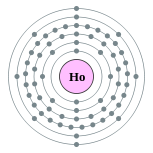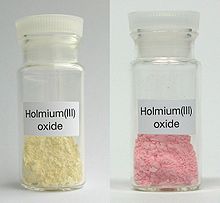
Holmium
Did you know...
SOS Children offer a complete download of this selection for schools for use on schools intranets. Sponsor a child to make a real difference.
| Holmium | |||||||||||||||||||||||||||||||||||||
|---|---|---|---|---|---|---|---|---|---|---|---|---|---|---|---|---|---|---|---|---|---|---|---|---|---|---|---|---|---|---|---|---|---|---|---|---|---|
|
67Ho
|
|||||||||||||||||||||||||||||||||||||
|
|||||||||||||||||||||||||||||||||||||
| Appearance | |||||||||||||||||||||||||||||||||||||
silvery white |
|||||||||||||||||||||||||||||||||||||
| General properties | |||||||||||||||||||||||||||||||||||||
| Name, symbol, number | holmium, Ho, 67 | ||||||||||||||||||||||||||||||||||||
| Pronunciation | / ˈ h oʊ l m i ə m / HOHL-mee-əm | ||||||||||||||||||||||||||||||||||||
| Element category | lanthanide | ||||||||||||||||||||||||||||||||||||
| Group, period, block | n/a, 6, f | ||||||||||||||||||||||||||||||||||||
| Standard atomic weight | 164.93032 | ||||||||||||||||||||||||||||||||||||
| Electron configuration | [Xe] 4f11 6s2 2, 8, 18, 29, 8, 2 |
||||||||||||||||||||||||||||||||||||
| History | |||||||||||||||||||||||||||||||||||||
| Discovery | Marc Delafontaine (1878) | ||||||||||||||||||||||||||||||||||||
| Physical properties | |||||||||||||||||||||||||||||||||||||
| Phase | solid | ||||||||||||||||||||||||||||||||||||
| Density (near r.t.) | 8.79 g·cm−3 | ||||||||||||||||||||||||||||||||||||
| Liquid density at m.p. | 8.34 g·cm−3 | ||||||||||||||||||||||||||||||||||||
| Melting point | 1734 K, 1461 °C, 2662 °F | ||||||||||||||||||||||||||||||||||||
| Boiling point | 2993 K, 2720 °C, 4928 °F | ||||||||||||||||||||||||||||||||||||
| Heat of fusion | 17.0 kJ·mol−1 | ||||||||||||||||||||||||||||||||||||
| Heat of vaporization | 265 kJ·mol−1 | ||||||||||||||||||||||||||||||||||||
| Molar heat capacity | 27.15 J·mol−1·K−1 | ||||||||||||||||||||||||||||||||||||
| Vapor pressure | |||||||||||||||||||||||||||||||||||||
|
|||||||||||||||||||||||||||||||||||||
| Atomic properties | |||||||||||||||||||||||||||||||||||||
| Oxidation states | 3, 2, 1 ( basic oxide) |
||||||||||||||||||||||||||||||||||||
| Electronegativity | 1.23 (Pauling scale) | ||||||||||||||||||||||||||||||||||||
| Ionization energies | 1st: 581.0 kJ·mol−1 | ||||||||||||||||||||||||||||||||||||
| 2nd: 1140 kJ·mol−1 | |||||||||||||||||||||||||||||||||||||
| 3rd: 2204 kJ·mol−1 | |||||||||||||||||||||||||||||||||||||
| Atomic radius | 176 pm | ||||||||||||||||||||||||||||||||||||
| Covalent radius | 192±7 pm | ||||||||||||||||||||||||||||||||||||
| Miscellanea | |||||||||||||||||||||||||||||||||||||
| Crystal structure | hexagonal close-packed | ||||||||||||||||||||||||||||||||||||
| Magnetic ordering | paramagnetic | ||||||||||||||||||||||||||||||||||||
| Electrical resistivity | ( r.t.) (poly) 814 nΩ·m | ||||||||||||||||||||||||||||||||||||
| Thermal conductivity | 16.2 W·m−1·K−1 | ||||||||||||||||||||||||||||||||||||
| Thermal expansion | ( r.t.) (poly) 11.2 µm/(m·K) | ||||||||||||||||||||||||||||||||||||
| Speed of sound (thin rod) | (20 °C) 2760 m·s−1 | ||||||||||||||||||||||||||||||||||||
| Young's modulus | 64.8 GPa | ||||||||||||||||||||||||||||||||||||
| Shear modulus | 26.3 GPa | ||||||||||||||||||||||||||||||||||||
| Bulk modulus | 40.2 GPa | ||||||||||||||||||||||||||||||||||||
| Poisson ratio | 0.231 | ||||||||||||||||||||||||||||||||||||
| Vickers hardness | 481 MPa | ||||||||||||||||||||||||||||||||||||
| Brinell hardness | 746 MPa | ||||||||||||||||||||||||||||||||||||
| CAS registry number | 7440-60-0 | ||||||||||||||||||||||||||||||||||||
| Most stable isotopes | |||||||||||||||||||||||||||||||||||||
| Main article: Isotopes of holmium | |||||||||||||||||||||||||||||||||||||
|
|||||||||||||||||||||||||||||||||||||
Holmium is a chemical element with the symbol Ho and atomic number 67. Part of the lanthanide series, holmium is a rare earth element. Holmium was discovered by Swedish chemist Per Theodor Cleve. Its oxide was first isolated from rare earth ores in 1878 and the element was named after the city of Stockholm.
Elemental holmium is a relatively soft and malleable silvery-white metal. It is too reactive to be found uncombined in nature, but when isolated, is relatively stable in dry air at room temperature. However, it reacts with water and rusts readily, and will also burn in air when heated.
Holmium is found in the minerals monazite and gadolinite, and is usually commercially extracted from monazite using ion exchange techniques. Its compounds in nature, and in nearly all of its laboratory chemistry, are trivalently oxidized, containing Ho(III) ions. Trivalent holmium ions have fluorescent properties similar to many other rare earth ions (while yielding their own set of unique emission light lines), and holmium ions are thus used in the same way as some other rare earths in certain laser and glass colorant applications.
Holmium has the highest magnetic strength of any element and therefore is used for the polepieces of the strongest static magnets. Because holmium strongly absorbs neutrons, it is also used in nuclear control rods.
Characteristics
Physical properties
Holmium is a relatively soft and malleable element that is fairly corrosion-resistant and stable in dry air at standard temperature and pressure. In moist air and at higher temperatures, however, it quickly oxidizes, forming a yellowish oxide. In pure form, holmium possesses a metallic, bright silvery luster.
Holmium oxide has some fairly dramatic color changes depending on the lighting conditions. In daylight, it is a tannish yellow colour. Under trichromatic light, it is a fiery orange red, almost indistinguishable from the appearance of erbium oxide under the same lighting conditions. The change is related to the sharp emission bands of the trivalent ions of these elements, acting as phosphors.
Holmium has the highest magnetic moment (10.6 µ
B) of any naturally occurring element and possesses other unusual magnetic properties. When combined with yttrium, it forms highly magnetic compounds. Holmium is paramagnetic at ambient conditions, but is ferromagnetic at temperatures below 19 K.
Chemical properties
Holmium metal tarnishes slowly in air and burns readily to form holmium(III) oxide:
- 4 Ho + 3 O2 → 2 Ho2O3
Holmium is quite electropositive and is generally trivalent. It reacts slowly with cold water and quite quickly with hot water to form holmium hydroxide:
- 2 Ho (s) + 6 H2O (l) → 2 Ho(OH)3 (aq) + 3 H2 (g)
Holmium metal reacts with all the halogens:
- 2 Ho (s) + 3 F2 (g) → 2 HoF3 (s) [pink]
- 2 Ho (s) + 3 Cl2 (g) → 2 HoCl3 (s) [yellow]
- 2 Ho (s) + 3 Br2 (g) → 2 HoBr3 (s) [yellow]
- 2 Ho (s) + 3 I2 (g) → 2 HoI3 (s) [yellow]
Holmium dissolves readily in dilute sulfuric acid to form solutions containing the yellow Ho(III) ions, which exist as a [Ho(OH2)9]3+ complexes:
- 2 Ho (s) + 3 H2SO4 (aq) → 2 Ho3+ (aq) + 3 SO2−
4 (aq) + 3 H2 (g)
Holmium's most common oxidation state is +3. Holmium in solution is in the form of Ho3+ surrounded by nine molecules of water. Holmium dissolves in acids.
Isotopes
Natural holmium contains one stable isotope, holmium-165. Some synthetic radioactive isotopes are known; the most stable one is holmium-163, with a half life of 4570 years. All other radioisotopes have ground-state half lives not greater than 1.117 days, and most have half lives under 3 hours. However, the metastable 166m1Ho has a half life of around 1200 years because of its high spin. This fact, combined with a high excitation energy resulting in a particularly rich spectrum of decay gamma rays produced when the metastable state de-excites, makes this isotope useful in nuclear physics experiments as a means for calibrating energy responses and intrinsic efficiencies of gamma ray spectrometers.
History
Holmium (Holmia, Latin name for Stockholm) was discovered by Marc Delafontaine and Jacques-Louis Soret in 1878 who noticed the aberrant spectrographic absorption bands of the then-unknown element (they called it "Element X"). Later in 1878, Per Teodor Cleve independently discovered the element while he was working on erbia earth ( erbium oxide).
Using the method developed by Carl Gustaf Mosander, Cleve first removed all of the known contaminants from erbia. The result of that effort was two new materials, one brown and one green. He named the brown substance holmia (after the Latin name for Cleve's home town, Stockholm) and the green one thulia. Holmia was later found to be the holmium oxide and thulia was thulium oxide. In Henry Moseley's classic paper on atomic numbers, holmium was assigned an atomic number of 66. Evidently, the holmium preparation he had been given to investigate had been grossly impure, dominated by neighboring (and unplotted) dysprosium. He would have seen x-ray emission lines for both elements, but assumed that the dominant ones belonged to holmium, instead of the dysprosium impurity.
Occurrence and production
Like all other rare earths, holmium is not naturally found as a free element. It does occur combined with other elements in gadolinite, monazite, and other rare-earth minerals. The main mining areas are China, United States, Brazil, India, Sri Lanka, and Australia with reserves of holmium estimated as 400,000 tonnes.
Holmium makes up 1.4 parts per million of the earth's crust by weight. This makes it the 56th most abundant element in the earth's crust. Holmium makes up 1 part per million of the soils, 400 parts per quadrillion of seawater, and almost none of earth's atmosphere. Holmium is rare for a lanthanide. It makes up 500 parts per trillion of the universe by weight.
It is commercially extracted via ion-exchange from monazite sand (0.05% holmium) but is still difficult to separate from other rare earths. The element has been isolated through the reduction of its anhydrous chloride or fluoride with metallic calcium. Its estimated abundance in the Earth's crust is 1.3 mg/kg. Holmium obeys the Oddo-Harkins rule: as an odd-numbered element, it is less abundant than its immediate even-numbered neighbors, dysprosium and erbium. However, it is the most abundant of the odd-numbered heavy lanthanides. The principal current source are some of the ion-adsorption clays of southern China. Some of these have a rare-earth composition similar to that found in xenotime or gadolinite. Yttrium makes up about two-thirds of the total by weight; holmium is around 1.5%. The original ores themselves are very lean, maybe only 0.1% total lanthanide, but are easily extracted. Holmium is relatively inexpensive for a rare-earth metal with the price about US$ 1000 per kg.
Applications
Holmium has the highest magnetic strength of any element, and therefore is used to create the strongest artificially generated magnetic fields, when placed within high-strength magnets as a magnetic pole piece (also called a magnetic flux concentrator). Since it can absorb nuclear fission-bred neutrons, it is also used in nuclear control rods.
Holmium is used in yttrium-iron- garnet (YIG)- and yttrium-lanthanum-fluoride (YLF) solid-state lasers found in microwave equipment (which are in turn found in a variety of medical and dental settings). Holmium lasers emit at 2.08 micrometres, and therefore are safe to eyes. They are used in medical, dental, and fibre-optical applications.
Holmium is one of the colorants used for cubic zirconia and glass, providing yellow or red coloring. Glass containing holmium oxide and holmium oxide solutions (usually in perchloric acid) have sharp optical absorption peaks in the spectral range 200–900 nm. They are therefore used as a calibration standard for optical spectrophotometers, and are available commercially.
The radioactive but long-lived Ho-166m1 (see "Isotopes" above) is used in calibration of gamma ray spectrometers.
Biological role
Holmium plays no biological role in humans, but its salts are able to stimulate metabolism. Humans typically consume about a milligram of holmium a year. Plants do not readily take up holmium from the soil. Some vegetables have had their holmium content measured, and it amounted to 100 parts per trillion.
Toxicity
Large amounts of holmiium salts can cause severe damage if inhaled, consumed orally, or injected. The biological effects of holmium over a long period of time are not known. Holmium has a low level of acute toxicity.




